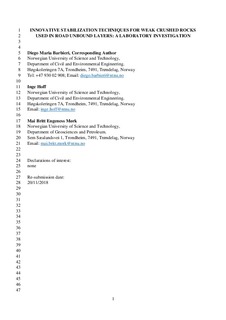| dc.contributor.author | Barbieri, Diego Maria | |
| dc.contributor.author | Hoff, Inge | |
| dc.contributor.author | Mørk, Mai Britt Engeness | |
| dc.date.accessioned | 2019-11-06T07:53:17Z | |
| dc.date.available | 2019-11-06T07:53:17Z | |
| dc.date.created | 2019-05-16T12:34:25Z | |
| dc.date.issued | 2019 | |
| dc.identifier.citation | Transportation Geotechnics. 2019, 18 132-141. | nb_NO |
| dc.identifier.issn | 2214-3912 | |
| dc.identifier.uri | http://hdl.handle.net/11250/2626778 | |
| dc.description.abstract | The “Ferry-free coastal highway route E39” project includes building several long tunnels along the southwestern Norwegian coast. The tunnelling operations will generate a large quantity of blasted rocks; these could be used in the road unbound layers close to the place of production to provide a sustainable cost-benefit application. The existing design guidelines define strength requirements for road unbound layers in terms of Los Angeles and micro-Deval tests. Even if the major part of the rocks has igneous origin and could potentially fulfil the standard tests, the damage induced by the confined heavy blasting makes the materials fail the check procedures. The research investigates how to enable the use of the “weak” rocks by investigating three possible techniques. The first approach is the mixture between the different types of rocks available in situ. The second approach is additive application; two different non-traditional additive types are examined: one is polymer-based, the other one is lignin-based. The third approach is the attempt to modify the rocks mineralogical structure by overheating. The research test campaign uses both the aforementioned standard tests and repeated triaxial load tests. Rocks mixture and additives application are viable and sustainable methods to improve the mechanical properties of the “weak” crushed metamorphic rocks. Overheating does not turn out to be an effective and convenient procedure. | nb_NO |
| dc.language.iso | eng | nb_NO |
| dc.publisher | Elsevier | nb_NO |
| dc.rights | Attribution-NonCommercial-NoDerivatives 4.0 Internasjonal | * |
| dc.rights.uri | http://creativecommons.org/licenses/by-nc-nd/4.0/deed.no | * |
| dc.title | Innovative stabilization techniques for weak crushed rocks used in road unbound layers: A laboratory investigation | nb_NO |
| dc.type | Journal article | nb_NO |
| dc.type | Peer reviewed | nb_NO |
| dc.description.version | acceptedVersion | nb_NO |
| dc.source.pagenumber | 132-141 | nb_NO |
| dc.source.volume | 18 | nb_NO |
| dc.source.journal | Transportation Geotechnics | nb_NO |
| dc.identifier.doi | 10.1016/j.trgeo.2018.12.002 | |
| dc.identifier.cristin | 1698336 | |
| dc.description.localcode | © 2018. This is the authors’ accepted and refereed manuscript to the article. Locked until 13.12.2020 due to copyright restrictions. This manuscript version is made available under the CC-BY-NC-ND 4.0 license http://creativecommons.org/licenses/by-nc-nd/4.0/ | nb_NO |
| cristin.unitcode | 194,64,91,0 | |
| cristin.unitcode | 194,64,90,0 | |
| cristin.unitname | Institutt for bygg- og miljøteknikk | |
| cristin.unitname | Institutt for geovitenskap og petroleum | |
| cristin.ispublished | true | |
| cristin.fulltext | preprint | |
| cristin.qualitycode | 1 | |

